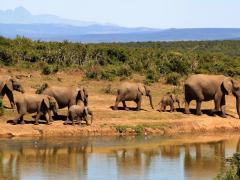Het belang van warmte in gezondheid en gewichtsverlies. Daarover gaat het boek van Brad Pilon. Dit is ook één van de boeken die mij inspireerden tot een compleet andere visie op obesitas.
- Is lichaamsvet gewoon opgeslagen "overschot" van calorieën?
Most people will tell you that our body fat is just stored ‘excess calories,’however, this is far from the truth. It is a well accepted fact that our ability to create and store body fat is an evolutionary adaptation that allows us to survive and reproduce in the face of temporary shortfalls infood availability [Higginson AD, 2012]. However, we now know this is only a small part of the function of our body fat. In many different types of mammals the cold season (winter for the northern part of theglobe) is when food is most sparse, yet it is also a time period that is typically accompanied by an increase in body size and fat mass.Interestingly, it is also the time where temperature is most threatening to survival [Ebling FG, 2015]. Even in humans it has been reported in multiple studies across various countries that these same seasonal variations in body size occur, despite plentiful access to food throughout the year [Capita R, 2005; Ma Y, 2006]. In general, we are alla little bit heavier and a little bit fatter during the colder months. This suggests that exposure to colder environments somehow drives us towards weight gain, as there seems to be a very strong and established relationship between mean annual temperature and obesity in humans,with maximum prevalence of obesity in counties with average temperatures near 18°C (64.4°F) [Voss JD, 2013]. There is a very strong relationship between mean annual temperature and weight gain.Intuitively, for a number of reasons we are about to discuss, it does seem possible that exposure to cold conditions could drive a gain in body fat as a way to protect us from the cold, as we have seen extremely strong evidence that colder climates relate to higher overall body weight in humans, and it has been discovered that our fat cells canactually sense and react to temperature changes, as do various other systems in our bodies [Ye L, 2013]. - Kortom, er is een duidelijke relatie tussen temperatuur en lichaamsgewicht. Koudere temperaturen leiden tot meer vetopslag door het lichaam. Dit geldt voor alle dieren. Niet enkel de mens. Dezelfde soort is kleiner in warme klimaten dan koudere klimaten.
Bergmann’s rule is a widely accepted, often tested and retested rule ofzoology created by Carl Bergmann, a 19th-century German biologist. Itis accepted to the point it appeared in numerous text books throug hout the years and is an integral part of our understanding of the biology of animals. Bergmann’s rule suggests that within any species of animal,body size varies with the environment in which they live. What this means is a species of animal living in colder environments (arctic fox)will tend to be larger than a member of that same species living in warmer environments (desert fox) [Bermann C, 1847]. - Deze link wordt niet gedreven door de beschikbaarheid van voedsel maar door de behoefte van het lichaam om zich te beschermen tegen extreme temperaturen met name extreme koude. Het lichaam wil immers niet sterven. En gebruikt vet om het lichaam te beschermen. Dit is één van de redenen waarom het lichaam dus vet opslaat --> overeten is daarvan het GEVOLG, niet de oorzaak.
Now, it would be easy to say that this relationship has to do with food availability or resource management, but time and time again, scientists have found that this phenomena is explained by heat production and loss – in other words not necessarily food and calorie availability, but the need to warm and cool the body [Gladwin T, 1949; Schrider E, 1951;Newman MT, 1953; Hanna JM 1989; Ruff CB 1994; Wells JCK 2012].While we often think of starvation as a threat our body is constantly worried about, the most immediate threat to life is fl uctuations intemperature. To be a little gruesome, you will die of extremes of heat or cold long before you would die of starvation. In this sense, you could think of temperature as an acute risk, and starvation as a chronic risk.
The reasons we are interested in Bergmann’s rule is because over the last 50 years, many anthropologists have concluded that modern humans are one of the many species that conform to this rule, meaning humans living in warmer climates tend to be smaller than humans livingin cooler climates [Gladwin T; 1949; Schreider E, 1950; Scherider E,1951; Newman MT, 1953]. Recently and importantly, it has been discovered that not only does temperature variability have an effect on overall body size, but it has also been shown to aff ect the amount of body fat on a person’s body [Wells JC, 2019]. Make no mistake, your fat has a very unique structure that gives it excellent insulating properties.In fact, you could make an argument that thanks to this specialstructure, its primary purpose is to act as the thermal insulation necessary for us to survive in colder environments and to act as the‘fuel’ for the engine that heats us. - Vet speelt zich rol op twee manieren: als insulator en als bron van brandstof voor interne warmte. Als bescherming dus en om het lichaam warm te houden. Ter zijde: dit is één van de redenen waarom mensen sneller een verkoudheid/koorts krijgen in de winter. Door de koude temperaturen wordt energie aan het lichaam ontnomen en moet het dus gebruik maken van interne energie: het lichaam verhoogt dus de temperatuur om de toxische stoffen in het lichaam te bestrijden en dit leidt tot "koorts".
Body Fat plays two important roles inthermoregulation: 1. Acts as thermal insulation 2. Acts as fuel for the creation of internal heat Of all the different types of biological molecules that make up your body, fats have the lowest thermal conductance and highest insulation potential [Alexander CM, 2015]. This means body fat is a great insulator, but it also contains a high amount of energy per gram, meaning it is also a great fuel source – which is exactly what our metabolisms need during the cold. - Het creëren van warmte is inderdaad één van de belangrijkste doelen van ons metabolisme en een belangrijke reden waarom we eten (nogmaals: eten is dus het gevolg van dit doel, we gaan eten omdat ons metabolisme warmte wil creëren.
This is because creating heat is one of the main purposes of our metabolisms and even a large reason why we eat. You will often hear scientists refer to heat as a byproduct of our metabolism, but this is amistake – it is not a by product, it is a product. In fact, there is a scientifi cschool of thought that suggests regulating our temperature is one of the primary roles of our metabolisms. According to this hypothesis,having a large body is advantageous in cold conditions not only because it has more cells and therefore produces more heat than a smaller body,but also because the relationship between the volume and surface area of our bodies is such that a larger body loses less heat per unit volume than a smaller body. We will dive deeper into this later, but the general idea is being larger in the cold will increase your chance of survival, as can being smaller when it is hot. This is because in both situations, your ability to ‘thermoregulate’ is improved.
In affluent countries, people spend close to 90% of their time inenclosed buildings and about 5% of their time in enclosed vehicles.These proportions are fairly constant across the various regions of theU.S. and Canada and for the California population between the late1980s forward. This means that on average only about 5% of our time is actually spent outside [Robinson JW, 1995].
Although historically indoor temperatures may have been closely correlated with outdoor temperatures, there has been a spread in central heating and air conditioning over the last 5 decades, and the useof air conditioning has allowed many of us to keep our homes within a tightly controlled range of temperatures termed ‘the thermoneutralzone’ [Biddle J, 2008]. The thermoneutral zone (TNZ) is defi ned as the range of ambient temperatures that a human body can exist in without needing regulatory changes in metabolic heat production or evaporative heat loss in order to maintain core temperature. In other words, the thermoneutral zone is the range of temperatures in which you will feel comfortable, and maintaining this comfort takes no additional energetic needs. - Het lichaam zal zich aanpassen wanneer we uit onze temperatuurcomfortzone zijn: door warmte te genereren (metabolisme - gebruik makend van vet) of afkoelen via zweet.
The thermoneutral zone for a nude body is approximately 26 to 33.3°C(78.8 to 91.94°F), above or below which your body will adapt by increasing your heat output, or cooling your body via sweat [Erikson H,1956; Gagge AP, 1967]. Now, I fully agree that 26 to 33.3 degrees sounds rather warm, but remember in the evolutionary sense, we are considered a tropical animal. Our anatomy as well as our physiology is geared towards life in moderate and warm environments [Clark RP,1985]. Not only this, but we certainly were not designed to thermoregulate via high tech clothing. - Mensen zijn evolutionair bekeken dus warmtedieren. Ons lichaamsgewicht (BMI) is lager als we vertoeven in behuizing met hogere temperaturen:
Most of us live almost exclusively in this artificial, slightly-cool thermoneutral zone. Rarely, if ever do we move outside of it, except for the rare occasions we spend time outdoors. It’s not an exaggeration to say that many of us live our entire lives in cool “thermal monotony” –which is maintained via our housing and our clothing, but not via our own built in thermo-regulatory abilities [Healy S, 2008]. Interestingly,data looking at over one hundred thousand adults taken from 13 consecutive annual waves of the nationally representative health survey for England (1995-2007) found that the body mass index (a generalmeasure of overweightness, often abbreviated as BMI) of the people residing in homes with air temperatures above 23°C (73.4°F) were lower than those living in an ambient temperature of under 19°C (66.2°F).When the scientists conducting this study further analyzed the data and controlled for the participants age, gender, social class, health and themonth/year of assessment, they found that high indoor temperatures were associated with lower body mass index levels in winter and non-winter months and in both the early (1995-2000) and later (2001-2007) survey years. - Het volgende had duidelijker geformuleerd mogen worden: welke regels achter gewichtstoenamen? De caloriehypothese opnieuw? Dat vettoename het gevolg is van te veel eten ipv. van omgekeerd?
However, I am not suggesting that cooler temperatures somehowmagically create body fat. Instead I am suggesting that cooler temperatures are the hidden ‘environmental drive’ that helps push us towards increased levels of body fat by the very known and understood rules behind weight gain. - Hier ben ik het dan weer wel mee eens:
This all suggests a very interesting reason why you are driven to eat more when you are cold. As a first response, you are trying to keep your core temperature up using the thermic effect of food, and as a more chronic response, you are attempting to build body fat not only to insulate you from the temperatures you are being exposed to, but also as a way to hold temperature inside of you. - We kennen allemaal het verschijnsel dat we minder honger hebben als het warm weer is. Reden is nu duidelijk: bij warm weer heeft het lichaam minder behoefte aan vet waardoor het hongergevoel verminderd en we eten dus minder. Een caloriedeficit is het GEVOLG van de lagere behoefte aan vet, niet omgekeerd. Idem voor overeten/calorie-overschot. Gevolg van behoefte aan een hogere vetmassa, niet de oorzaak ervan.
Conversely, in warm weather we eat less, acutely lowering the heatcaused by eating and digesting, and chronically allowing us to lower ourinsulation by losing body fat. This raises the distinct possibility that sometimes we may be overeating simply because we feel cold. - Insuline vertelt hetzelfde verhaal:
Measuring insulin sensitivity can be difficult since insulin sensitivity canvary depending on which tissue in your body is being measured. In other words, your liver may have a diff erent level of sensitivity than your skeletal muscle or your body fat, but in general most measurements taken in research are of an averaged ‘whole body’ insulin sensitivity. An association between ambient temperature and increased insulin resistance has been found in studies on people who spend more time outside or without air conditioning and thus are more prone to be affected by seasonal changes in ambient temperature [Valdes S, 2019].Furthermore, various studies show an increased incidence of type 2 diabetes have been found in people living with higher mean annual outdoor temperature both across the United States and worldwide,suggesting that insulin ‘works better’ in the cold [Blauw LL, 2017,Speakman J, 2016]. More directly, it has also been shown that short-term cold acclimation improves insulin sensitivity in patients with type 2diabetes, an effect that was associated with markedly increased skeletal muscle insulin sensitivity [Hanssen MJ, 2015]. Now, a decreased insulin sensitivity may sound like a bad thing, but keep in mind that the overall net effect we are exploring is one of weight loss, and weight loss in and of itself can significantly improve long-term insulin sensitivity in both men and women [Wong MH, 2012; Svendesn PF, 2012]. So while‘insulin sensitivity’ is generally considered to be a good thing, what we are looking for right now is evidence that heat can alter your insulin levels in a way that would push you towards weight loss, and this seems to be what we have found. Temperature can even influence your glucose metabolism over a very short period of time. An Oral Glucose Tolerance Test (OGTT) is a standard way to test a person’s glucosemetabolism. To take an OGTT you would simply drink a solution containing 75 grams of glucose, then have your blood glucose levels monitored for several hours. During this time, we would hope to see a‘normal’ rise and fall of blood glucose, demonstrating you had normal glucose metabolism.
However, a little known fact is that your response to an OGTT is highly temperature dependent. When an OGTT was randomly performed at either 31°C (87.8°F) or at 22°C (71.6°F), blood sugar levels raised higher and stayed elevated for longer when the OGTT was performed at 31° C[Antoine-Jonville S, 2019]. This research illustrates a strong relationship between temperature, insulin and both your glucose and fat metabolism. Not only is the relationship strong, but it’s aff ected by both heat and cold, where colder temperatures improve our insulin sensitivity and ability to store excess calories, and warmer temperatures decrease our insulin sensitivity, weakening the storage signal that comes from insulin. - Idem met groeihormoon: insuline neemt toe met kou, daarmee wordt het opslaan van calorieën als vet bevorderd. Groeihormoon neemt toe met hogere temperatoren, waardoor de vetverbranding wordt gestimuleerd.
Heat causes your body to release growth hormone into your bloodstream. In fact, exposing the human body to heat has been used in clinical medicine, especially in the field of pediatric endocrinology, as a way to test for normal growth hormone release. If GH is not released as a response to heat, then it is indicative of a medical condition knownas pituitary insuffi ciency [Radomski MW, 1998]. Furthermore, not only does heat increase GH release, but cold exposure blocks it. Just as insulin increases with cold and decreases with warmth, growth hormone tends to the opposite – decrease with cold, then increase upon rewarming [Okada Y, 1970].
Growth hormone is also highly infl uenced by exercise, with short,intense exercise being a well known way to increase growth hormone levels [Deemer SE, 2018]. In a study examining the effect of temperature on this well known phenomena, 10 subjects did exercise at an ambient temperature of 40°C (104°F) and then again on a another day at a temperature of 10°C (50°F). At 40 degrees, exercise produced an increase in growth hormone levels in all 10 subjects, while in the cold only one subject showed a rise in growth hormone as a result of exercise [Frewin DB, 1976]. - Ook leptin werkt volgens hetzelfde principe: meer leptine wordt geproduceerd bij hogere temperaturen --> minder honger. Opnieuw: als je lichaam minder vet nodig heeft, heb je minder hoger en als je lichaam meer vet nodig heeft, wordt het hongergevoel gestimuleerd en ga je zogenaamd "overeten".
Interestingly, leptin has been found to be infl uenced by temperature,and in a way that fits our model: Leptin goes down in the cold, and heat increases leptin levels [Ricci MR, 200; Yu S, 2016; Yu X, 2019; Zhang Y,2011]. Leptin goes down in the cold, and heat increases leptin levels. In fact, recent research suggests that leptin plays an important role in thermoregulation and helping the body regulate its internal temperature relative to changes in outside temperature, further connecting the role of leptin and the thermoregulation of your body[Kaiyala KJ, 2016; Fischer AW, 2016].
This means that exposure to cold will decrease leptin levels, creating a push for an increased food intake and an eventual increase in body fatness, whereas exposure to heat will increase leptin levels, lowering long-term food intake and pushing for a decreased level of body fatness, fitting our model very well.µ - In dit licht kan ook de rol van sport worden herzien als meer dan enkel het verbranden van "overtollige" calorieën. Niet alleen zal sport in warmere temperaturen meer vet doen verbranden maar zal het hongergevoel minder stimuleren dan sport in koudere temperaturen (precies zoals voorspeld).
Based on this evidence, we can then expand our theory on heat tos uggest that while traditionally we have thought that chronic exercise causes fat loss simply because it is able to burn a lot of calories, it is very possible that chronic exercise causes fat loss as a function aladaptation to release heat from your body. Fat loss may be a functional adaptation to chronic exercise as a way to allow for better release of heat from your body. Evidence to support this theory can be found in‘hot exercise’ like Bikram yoga, where yoga exercise is performed in highheat (40 degrees Celsius, 105 degrees Fahrenheit). When yoga in the heat was compared to the exact same yoga routine performed at normal room temperature (23.3°C, 74°F), it was found that the heated exercise caused an almost doubling of the amount of fat being oxidizedas a fuel [Lambert, BS, 2020]. However, for this to be true, then we would need to see not only exercise and heat create more fat loss, but also exercise in colder temperatures causing less fat loss. Interestingly,while exercising in the heat has been shown to increase growth hormone levels and thus promote the use of body fat as a fuel source,exercise in the cold is known to blunt this growth hormone response and lessen the amount of body fat being used as a fuel [Frewin DB,1976]. Furthermore, while an acute bout of exercise has been shown to cause a temporary decrease in appetite and food intake, which would support the loss of body fat [King JA, 2010; Ueda SY, 2009; Sim AY,2014], exercising in colder temperatures may lessen this effect. Additionally, when people exercise in either cool water orthermoneutural water and were then given a meal, the amount they chose to eat was 44% higher after exercising in cool water than it was following the exercise session in thermoneutral water [While LJ, 2005]. Along these lines, overweight men and women ate 11% more after a45-min walk at 8°C (46.4°F), relative to the amount they ate afterwalking at 20°C (68°F) [Crabtree DR, 2015]. Finally, twelve male athletes performed high-intensity intermittent exercise that was either followed by 3-minute exposure to whole body cryotherapy (an extreme,yet very brief exposure to -140 degree Celsius temperatures that is currently popular in athletic therapy) or a normal rest period. Thirtyminutes later the athletes were allowed to eat a buff et meal and theircalorie and macronutrient intake was measured. Importantly, eventhough the subjects did not report feeling any hungrier, their calorie intake during the buff et meal was signifi cantly higher after the wholebody cryotherapy treatment [Kojima C, 2018]. This supports the idea that the heat generated by exercise may be a signal to reduce body fatmass as a way to help our bodies control our internal body temperature,and that exercising in the cold (and thus removing some of the need for thermoregulation) has the ability to blunt this eff ect.
An interesting point with these last 3 studies is that the resistance training performed by the people in these studies was of very low intensity, and other studies that used resistance training of a higher intensity did not find similar results. As lower intensity exercise would create less heat than higher intensity exercise, it is possible that adding heat to low intensity exercise simply mimics the amount of heat created by higher intensity exercise. This adds evidence for the suggestion madein our last chapter that the heat created by exercise may be partially responsible for the adaptations caused by resistance training [StadnykAMJ, 2017].
However, for this to be true, that the heat created by exercise is responsible for the muscle growth that occurs with exercise, we would need to see a mechanism, or a reason why this happens. We know warmth does increase the growth hormone response to exercise, and itaff ects the cytokine response to exercise, both of which are known to cause muscle growth, however this is not enough evidence to show a mechanism behind heat’s effect of muscle growth. One mechanism that has recently been discovered is that heat exposure may be able to increase the activity of muscle satellite cells needed for muscle growth[Lee H, 2018]. Satellite cells are like ‘dormant muscle seeds’ that sit onthe outside of the muscle fi ber (hence the name satellite cells). They arepresent in all skeletal muscles and are associated with all muscle fi bertypes. You can think of satellite cells as the body’s reserve of muscle cellnuclei. Satellite cells are crucial for skeletal muscle adaptation toexercise. Without satellite cell activation, there would be very little possibility for muscle growth in the human body. So the eff ect of heaton the activity of satellite cells may be one of the ways heat can aid in muscle growth. However, one of the most important ways heat mayaff ect muscle growth is through the regulation of something called mTOR. Mammalian TOR (mTOR) is a protein signaling molecule that is thought of as the ‘master regulator’ of muscle growth. mTOR activates cell growth by positively and negatively regulating several anabolic andcatabolic processes that collectively determine muscle massaccumulation [Hall MN, 2008]. mTOR is also essential for the activation of the satellite cells we just discussed [Zhang P, 2015]. mTOR is activated or ‘phosphorylated’ in response to nutrients (such as aminoacids), growth factors (such as testosterone), and as a response to resistance exercise (lifting weights) and heat. Recently, it has beenfound that the addition of 20 minutes of heat before exercise, raising muscle temperature to approximately 41 degrees Celsius, and then continued heating throughout a resistance training exercise period is able to enhance the mTOR response to resistance training [Kakigi R,2011]. Furthermore, short-term exposure to heat has been shown to increase the phosphorylations state of mTOR, meaning it was able to turn mTOR to the ‘on’ or ‘activated’ position. It was also able to increasethe actual amount of mTOR in a sample taken from people’s quadriceps muscles [Ihsan, M, 2020]. This illustrates that short-term exposure to heat is able to enhance anabolic signalling in muscles through the activation and increase in the number of mTOR in a muscle.
This means that we have a well-studied mechanism (mTOR activation)to support the fi ndings that heat can aid in muscle growth. Interestingly, not only does exposure to heat by itself have the ability to enhance anabolic signalling, but heat may also help exercise build muscle by a completely diff erent, yet still very useful manner. Heat improves muscle performance. The performance of skeletal muscle is optimized within a specifi cthermal range, this is one of the mainreasons we are told to ‘warm up’ before exercise – the goal is literally toincrease the temperature of our muscles above the normal resting temperature [Somboonwong J, 2015]. An increased muscle temperaturecan cause substantial improvements in force production, faster rates offorce generation, relaxation, shortening, and production of power output, all beneficial to overall muscle performance [James RS, 2020]. Indeed, a number of studies have shown that the temperature of your muscles is the most important factor in determining the outcome of exercise performance, especially during short-term, high-intensity exercise [Oksa J, 1996; Oliver RA, 1979; Racinais S, 2010]. - Blootstelling aan hitte bevordert dus ook de groei van spiermassa:
In conclusion, heat exposure is able to increase muscle mass, likelythrough its actions on the regulators of muscle growth like mTOR and growth hormone and their eff ects on satellite cells, while cold exposureis able to reduce muscle mass, likely by inhibiting these same pathways[Roberts LA, 2015]. Warmth is also able to improve the muscle growth response to exercise, possibly due to the combination of activation of mTOR and optimization of muscle performance as muscles perform better when warm, resulting in better workouts and as a result better muscle growth. These findings are incredibly important, not only for the avid gym goer who wants to optimize their physique, but for the people who cannot workout due to injuries or medical conditions. Heat therapy may serve as an ‘exercise alternative’ for people who cannot workout. - Blootstelling aan warmte kan ook levensverlengend werken:
When you consider the fact that chronic infl ammation has beensuggested to be a major cause of the aging process (this has been calledthe “Molecular Infl ammatory Theory of Aging”), this could make exposure to heat an interesting tool for not only weight loss, but also away to combat chronic infl ammation and possibly increasing yourlifespan. Maar wat dan met de koude therapie (koude douches, ijskoud bad etc...)? Dat zou toch helpen om vet te verliezen? Maar dat is een korte termijn effect, op lange termijn leidt het tot meer honger en dus net toegenomen vetmassa (want daarvoor is het vet net aanwezig : om ons te beschermen tegen de koude temperaturen, en om voor voldoende interne energie te zorgen aangezien de koude therapie net energie wegneemt):
We also know that when we are exposed to cold temperatures, we get a quick increase in our metabolism as a way to generate heat to maintain warmth. And while many people simply stop at this fact and use it as evidence that exposure to the cold increases our metabolism and thus causes more fat loss, they are overlooking the fact that this very shortterm increase in metabolism is accompanied by an increased drive for eating to increase our internal temperature through the thermiceffect of food and to eventually protect us from the cold by increasing our levels of body fat.
Cold exposure does increase metabolic rate and it also causes improved insulin sensitivity, however it also decreases growth hormone levels, and chronic cold exposure leads to a gain of body fat, as an adaptation to not only protect us from the outside temperature, but also to help us hold in our metabolic heat to increase our internal temperature (It helps hold the heat from our metabolisms inside our bodies). Cold exposure increases our metabolic rate as a way to increase the internal temperature of our bodies, and it does so (at least partially) through the activation of something called brown adipose tissue.
Lean people have more BAT because they NEED more BAT in order to stay warm in cold environments. People with more body fat have less BAT because they NEED LESS BAT, because they have more insulation due to their higher amount of body fat. A lean person will start to feel cold a degree or two above the temperature at which an overweight person will feel cold, and as we’ve discussed previously, since they haveless body fat, they are able to hold in less heat, so they have a more urgent need to create internal heat when in a colder environment. Ittakes time and a large surplus of calories to create body fat, so theyrequire a more immediate solution. As an example, you would have to eat an additional 40,000 calories above your normal calorie intake to increase your body fat by roughly 10 pounds. Accomplishing this over afew days or even weeks would be extremely diffi cult, however this would be an easy task for you to do over a few months, but that doesn’t meet your immediate need to protect yourself from the cold. This is where brown fat can help protect you in the fi rst few weeks while your body increases your hunger and adapts your hormones to favor thecreation of new body fat to protect you from the cold. In other words, it makes sense that lean people would have more BAT and more active BAT as BAT is what is keeping them warm in this emergency situationsince they don’t have the necessary insulation from their body fat. Thismakes BAT an emergency plan of sorts to combat cold temperatures,while they build up enough body fat for a more long-term adaptation.BAT is a protective mechanism to protect people who are lean from cold temperatures. Thus, increasing the amount of BAT in someone who is overweight doesn’t necessarily mean they will need to use this BAT asthey are already protected by the cold. In fact, the metabolic response to a lower temperature will always be lower in someone who is overweight because body fat helps hold the metabolic heat in, thus maintaining their core temperature.
The truth is, it seems unlikely that BAT protects us from weight gain in the long term, or helps us lose weight, when its sole purpose seems tobe to help us survive in colder temperatures. In other words, being lean and being exposed to the cold (like outdoor workers) will lead you tohaving more BAT, but having more BAT may not lead you towards being lean. [Huttunen P, 1981]Conclusie: minder vet? Zoek de warmte op! (Infraroodsauna bvb.). Het bevordert ook de spiergroei, en meer spieren creëert meer interne warmte waardoor minder vet nodig is. Winwin. En nog leuker: eten creëert warmte! Eet dus ook voldoende want dat levert meer warmte op en MINDER nood aan vet;
So if we want to drive body fat levels down, then we need to chase heat. This means the temperature of your home, the use of saunas,exercise and the foods you eat all become weapons we can use to stay warm, and thus lessen the need to have body fat as insulation. More muscle mass means more internal heat produced, which means less need for insulation from body fat. Using this muscle mass via exercise creates even more heat, lessening the need for insulation even more. Eating food creates heat. The more time we spend eating near-maintenance amounts of food (as opposed to constantly being onhighly restrictive diets), the more heat we produce, the less you need insulation from body fat. Exposure to slightly higher ambient temperatures by increasing the heat of your home (again, slightly) may also have long-lasting eff ects, as may regular use of saunas, if possible.Heat alone won’t miraculously make the fat drip off your body, but it does have the ability to make weight loss easier, and that’s our main goal. It also helps reposition our approach to weight loss. Instead of chasing a fast metabolism, we’re chasing heat, and reminding our body that we no longer need the extra insulation from our body fat. The goal is to chase heat, keeping in mind to use common sense. Heat stroke and heat illnesses are very real; we want to slowly expose our bodies toslightly more heat – overheating ourselves with extreme temperatures will not cause the eff ect we are after.









